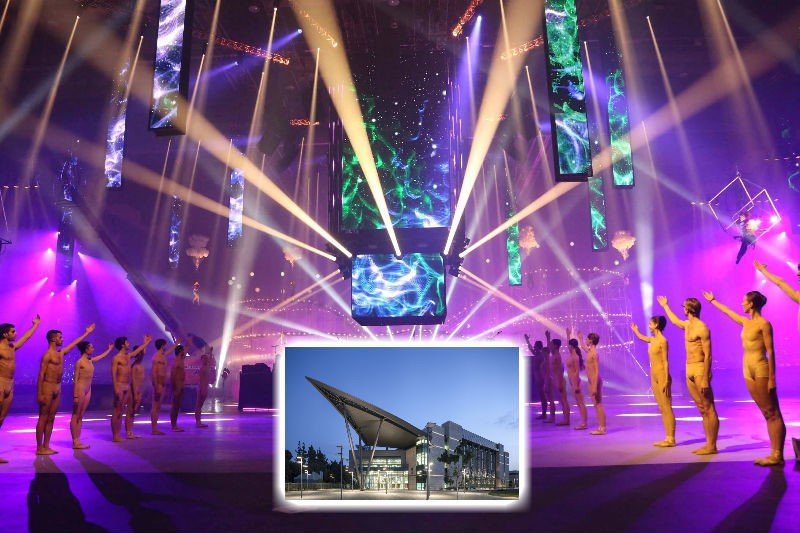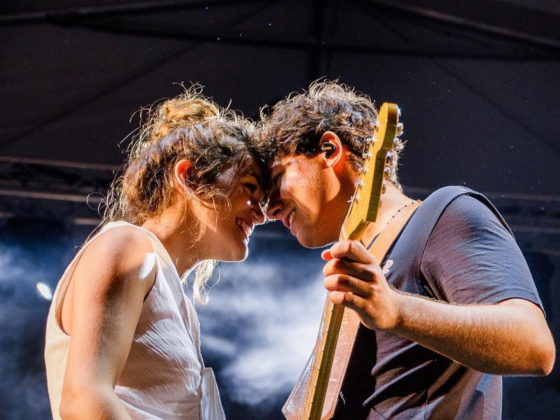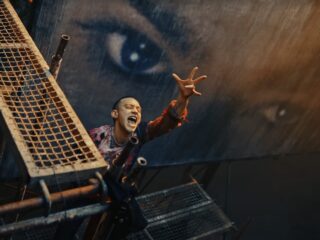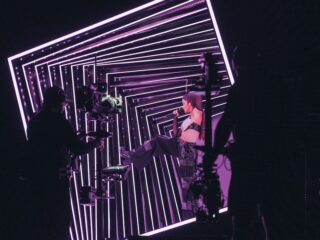Last week Israel Hayom revealed that KAN had published a tender for the construction of the Eurovision 2019 stage. In it they specified that they intend to increase the capacity of the audience, and it was suggested that KAN would consider downsizing the stage to achieve this.
We’ve now combed through their weekend edition and discovered additional details about the tender, which may offer insight into KAN’s general plans for the arena and the show. We’re happy to present you with the major points.
A sealed tender
The tender is a sealed one. This means that KAN and the EBU have invited specific candidates to apply. As this is a tender, no names were given but they contacted respected stage designers both in Israel and abroad. How much do you want to bet that a certain Florian Wieder was on their list?
Usually the best offer wins — and not just artistically but also economically. If two offers are equally good then an Israeli designer will probably be selected. While they’re thinking globally, the preference is likely to act locally. Beyond this the identity of the designer is irrelevant provided that they comply with the terms of the tender.
The concept
The main condition in the tender deals with the concept of the production as a whole. This has been defined as follows:
“Despite the fact that Israel does not form part of Europe, it has been connected to it since the beginning of history….in Israel this spirit and soul are embodied. Israel is a modern country representing globalization on the one hand, and personal interactions between its people on the other. Israelis like being together, and to feel united. Israelis live in a challenging area and are well-connected to the world surrounding us. Israel is a colourful, diverse and multi-cultural country. As such, it is based upon respect and acceptance. It is a traditional country but also an innovative and modern one, like the values of the Eurovision”.
Although this sounds quite general on first glance, there is also a message to Europe, which is perhaps delivered due to the calls to boycott Eurovision 2019 in Israel. Talk of boycotts almost seems passé now that 38 countries have already confirmed their participation before the deadline.
“Israel invites you all to celebrate the aspiration and desire to come closer and to be united. Israel is capable of doing this even better with you.”
One can’t help but wonder whether this invitation suggests that the Eurovision 2019 slogan will be based on a similar concept such as “when the past meets the future” as suggested by some fans.
Curiously, in a survey made by the biggest Eurovision Israeli fan groups on Facebook, the most desired slogan is simply “Shalom, Europe!”. Here at wiwibloggs a similar suggestion was made alongside some other original ideas.
It is also worth mentioning that the second most desired slogan is “Kapara Aleichem”, a slang expression used for exaggerated affection and appreciation, which is what Netta said after her performance both in the semi-final and in the final…
The stage
One of the main sections of the tender deals with the stage. It states that its design must be “iconic, with an Israeli identity, unique, modern, innovative and creative, significant and multi-purpose”. The conditions also require that the design would conform with the branding of Eurovision in general but also with the fact that the contest is taking place in Israel this time. This may also suggest that both modern and traditional elements will be brought together.
As regards to the stage itself, it appears that the LED screens are going to play a significant role, as indicated by one of the organizers:
“The stage is a very important part of the show and it must allow many options in terms of the production. In Portugal there were no LED screens. Instead, pyrotechnics and lightning were used which made some of the entries look the same”.
He also added that the stage will appear different for each entry and therefore it must be versatile to allow many alternatives. As Israel is a start-up nation with many hi-tech companies “the audience will expect to see a very progressive Eurovision in that aspect and this is what we intend to deliver“.
Although we suspect that Eurovision 2019 stage will be down-scaled, judging by the article from Israel Hayom and the statements made by the organizers, it appears that KAN knows that one of the key aspects for a successful Eurovision is the size of the stage. The organizers emphasise that the stage must be impressive and that KAN is open to various suggestions such as round or triangle shapes with or without a catwalk. The tender obliges each applicant to provide eight different vantage points of the stage, five different vantage points of the green room and three different vantage points of the EBU supervision area.
The show’s lineup
As we are in the very premature stage of the production, the line-up is still unclear, although some initial ideas are being considered. According to Israel Hayom, KAN plans to continue the tradition that started two years ago in Stockholm – a parade with all the candidates appearing from different sides of the stage.
Israel Hayom also confirms what has been speculated previously, namely, that the green room will be located outside of the venue due to its relatively small size. Under the tender’s conditions, the green room must include 26 separate areas for the delegations with at least 10 seats each, including a designated area for press. It is also specified that the green room should be “in line with the design of the stage and its space must be used effectively”.
The green room will also include 2,000 additional seats to allow more spectators to watch the show “as live as it can be”. The main reason is to increase audience capacity but also to ensure that more fans attend the show. This is because 60% of the tickets (c. 5,000 out of 9,000) are allocated to delegations and EBU associations, leaving only 4,000 for fans. KAN understands that more fans means more celebration and happy vibes as stated by one of the organizers:
“One of our concerns is that the audience will be “indifferent” because many of them are invited and are not typical fans. Fans are very important as they contribute to the energy in the arena. Our aim is therefore to sell as many tickets as we can to the public”.
Security
A specific condition in the tender demands maximum security in order to avoid incidents such as the one we’ saw recently in Lisbon when a stage invader crashed SuRie’s performance. The tender reflects this: “the final design including any adjustments will be subject to the security demands, in specific, to disallow any access to the stage”.
International Convention Centre CFO, Mr Tamir Dayan, says that the ICC fought for the right to host the contest despite the relatively small size of the venue compared to the Pais arena in Jerusalem and that the ICC can assure that the preparation and execution will be “outstanding”.
Eurovision 2019 timeline
This is the estimated schedule for the upcoming events regarding the tender and constructions.
- October: submission of applications by interested applicants
- November:
- selection completed by KAN and EBU
- approval of the concept
- December to February: submission of a detailed plan
- End of March – Mid April: construction
- End of April: Technical rehearsals
- Early May: Artists’ rehearsals
What do you think about the initial plan? Can you imagine the stage already? Do you think that adding 2,000 seats will address fans’ concerns? What about the suggested slogans?
Share your ideas with us below!








I really liked their stage from 1999 when they were hosting it. Very interesting style. I just wish that we could go back to 2014 in terms of stage and backing singers. I don’t like how it’s been in recent years.
LEDaholic fans will have multiple orgasms for sure XD
So many things are already “iconic” these days. We need a new word.
How about this (William and Deban call me, but you can’t) the slogan for the contest would be “Find Your Flow” as it is serving some Tel Aviv realness. The show would be hosted by Chen Aharoni, Lucy Ayoub and the legendary Gal Gadot and they would all take turns at Green Room duty. The stage would consist of an LED ornamental ring above and if you look down it resembles a clock as Tel Aviv is (one of) the city that never sleeps. And if that wasn’t enough, for the opening of Semi Final 2 the hosts would be… Read more »
But please DON’T use red lights! XD
LEDs does take away the props. In 2017 we have seen some of the most cringy props like canons, baloons, pyramids and giant moons. As for LEDs, excuse me, but since when is seeing a giant moving selfie interesting?…
“A giant moving selife”: Amusing, but accurate. If it becomes a disturbing trend, where we eventually (perhaps within a few as the next 3 years) see a dozen countries splatter the artists’ faces across the LED screens for lack of creativity, that’ll be the time to take an extended break from the LED screens. They saw the early signs that this trend was in the early stages of mushrooming out of control, and maybe that’s why they decide to take a break in Lisbon.
* I meant does *not* take away the props. And I forgot the most notable of all the 2017 props… our dear Italian monkey.
Not nice to criticize publicly the previous host. And besides, LEDs turn every act into the same thing.
Yes, the leds are back! Finally!!! After the simple, awful stage in Portugal, it’s a great news!!!
When creativity lacks let’s get LEDs. Awful is your taste.
I prefer without LED. Better stanging, less video gaming.
Hmmm… A DOTA 2 fan here, maybe? 🙂
Let me guess, a star shaped stage like the Israeli flag?
That’s a pretty great idea, actually. Or a circular/hexagonal stage with a star LED floor.
Will it be a 4K production? KAN has a special channel used for 4K, which broadcast the World Cup in 4K this summer.
I guess it depends on the budget, but it is very likely to happen.
Last year’s stage was a huge disappointment. It was very lame on TV. Please change the stage designer! Copenhagen 2014 and Stockholm 2016 are still the best stages so far from the last couple of years
About the LED-etc. things. 1. There are pros and cons for applying LED or not. LED can effectively fill and enhance stage, but can distract the focus from, or drown, the performer. Non-LED stages put more personal touch, yet can be so void and liveless if not utilized well. 2. Each broadcaster has their own right to choose the staging to set up the theme they want to convey. Big LED for a festive sensation? Sure! Maybe just some lighting to make it personal? That can do! 3. . . . do not forget, we have other options of lighting… Read more »
Hallelujah to the return of LEDs! No Eurovision should happen without that. Not sure how exactly you give a stage an Israeli identity but I guess we’ll see. In that case, i would consider it rather inappropriate though if the gig went to the guy who does it literally all the time. Also, an audience not consisting of your typical Eurovision fan wankers does not automatically mean they’re indifferent. Although I will admit that the invitation-only audience selection in Jerusalem 1999 was a rather pathetic state of affairs. As far as the information in this article is concerned, the organizers… Read more »
You fill the stage with hot guys, this is how you make it Israeli.
Well, the can do so for the interval or the hosts, but we are talking about the stage itself here which apparently should have an Israeli identity. Or do you suggest just leaving the hot guys for all the countries as part of the inventory?
Bring the Golden Boys back!
LED must be there. Is a must in 2019. National finals have LED, why not Eurovision? Each country must decide if it will use it wisely, or not. In my humble opinion :
-Doredos don’t need LED, Fokas Evangelinos does not need LED.
-Jacques Houdek used LED wisely, to show the duet.
-Australia 2017 was a victim of Sasha Jean Baptiste, her lack of imagination just put Isaiah face on big screen. Only her fault, not the host’s.
National finals have LEDs because it has become a cheap technology and evey vulgar TV show use them now.
I would prefer a stage without LED screens. Most countries just relay on those screens and the result is a boring performance. It was much more interesting last year. Whatever
5K seats out, wow! Most countries really need to save money in advance for non-profit event.
I hope whatever design KAN come up it will be enough to satisfy everyone’s stage performances. It was a bit cringey this year when almost everyone decided to bring their own ministage to supplement the LED-free stage.
Almost everyone would be an exaggeration. According to my observation, there are probably 21 acts out of 42 with non-instrumental props and only 9 of them have ministages.
Those numbers are very telling and do not aid your point at all, actually.
Let me clarify my point, then. The acts using ministages (yes, only ministages, not including other props) in 2018 are Belarus, Austria, Finland, United Kingdom, Czech Republic, Sweden, Bulgaria, the Netherlands, and Azerbaijan (this one is debatable, but I considered those as ministages). Counting 9 acts out of 42 as “almost everyone” is considerably an exaggeration. This probably isn’t that valuable of an information, but more of a confirmation.
I am not calling them everyone. I am saying that nine countries (I did not count, I am taking your numbers here) feeling the need to enhance the actual stage is a very high number. Those countries obviously thought they weren’t given enough options with that stage. Also keep in mind that probably not every country could afford having their own stage, maybe even more would have liked to bring their own. Also, speaking of affordability, Germany comes to mind off the top of my head, as you did not include it. Correct me if I am wrong, but didn’t… Read more »
Well, I was reffering to FFML’s point to say there are only 9 performers with actual ministages (the ones that you can step on), but here we go. There are more than just nine performers that doesn’t have a good option to fill the stage. Referring to James’ comment down below, prop-less stagings also suffered from the lack of LED. Yes, the delegations would have liked to bring more to their staging but don’t have the logistics to do so. Yes, Germany brought a half-circular LED screen. I have to agree to your point that some staging felt void and… Read more »
This also happened with LEDs… Canons, baloons and moons anyone?…
Well, we can’t deny those! At least, Lucie’s mermaid shell is out of cringe, it’s beautiful.
With that I agree. It was indeed beautiful and classy.
Oh yes… And I forgot monkeys…
Why do you capitalize KAN? It’s not an acronym in Hebrew.
Probably for greater emphasis and highlight the fact that it is the name of the broadcaster. I do wonder how IPBC decided to use this as their shortform brand name in the first place.
‘Kan’ mean ‘Here’ in Hebrew, and this is their reasoning for choosing it as their brand name: “After examining dozens of proposals, the IPBC management chose […] the name ‘Kan’, which symbolizes the commitment to express the diversity of currents in Israeli society and the pluralism that characterizes it. We are here, preparing for an independent, diverse and high quality public broadcast […] ‘Kan’ expresses the recognition that public broadcast is a part of Israeli society, belongs to Israeli society and is the means of expressing all that is happening here.” The brand name was revealed in July 2016, at… Read more »
The last program of the IBA was the Eurovision in Kiev. We thought that IMRI ZIV will be the last one that we send. Everyone were in total shock !!!! They put this song for goodbye (in the link) after the Eurovision in Kiev and shut down the channel…https://www.youtube.com/watch?v=_fHJmz4KMP8
Such a drama, but already then many said that Israel would probably continue to participate. A lot of it was just politics, since KAN seems to not like so much the government of Bibi. From what I see, KAN is a more modern station than IBA was. So seems to be working out alright?
Actually, yeah. The crew of KAN is in average much younger than the crew of IBA and this can really be felt. They listen to demands from their audience (although they have a rather small share of it) and deliver the best experience they can (i.e. being the first local 4k broadcast in Israel with the world cup this summer).
I kinda want to see Tel Aviv do a 360° stage with a LED screen for a cool backdrop.
How is it even possible to have a backdrop in a 360° stage?
A 360° stage has no front or back, it’s surrounded by seats.
Instead of having LED, they could use projections, something like Copenhagen ’14.
In a A 360° stage you don’t have a backdrop on which to project.
You can have a big backdrop far away, like in 2011. The problem is that those stages need to have huge ramps for the props, if the stage is surrounded by audience – there’s no way to move the props in and out. That’s why even in 2011 it wasn’t really a 360 stage.
Again, having a backdrop means the stage has a front and a back, and obviously there’s no audience behind it or it would block the backdrop – so it wouldn’t be a 360° stage.
Indeed the logistics is also an issue.
Something like JESC 2010, perhaps?
It was so good without LEDs in Portugal, it made artists work for more interesting performances.
Except it didn’t work. It had some of the most uninspiring staging ever. LED screens need to be featured heavily, and then each delegation can choose whether to use them or not.
Is it a norm for most big shows to have gigantic LED screens? LED can do well, but it can have even more uninspiring results, like those geometric shapes and gigantic portraits in 2017. Featuring it heavily would give us excessive drown of screens like 2009. It’s all back to the broadcasters’ choice to feature LED.
Tell me about those images in Ukraine, all those faces on the screens. That’s uninspiring.
Of course it did work. What did not work was the uninspired LED videos in Kiev
Finally someone says this! Thank YOU!
The stage in Lisbon was fine without the need of a LED backdrop. The reason that some performances looked the same for some is probably because the space was not adequately utilized. In most recent contests with LED’s, the backdrops tend to be too distracting that the attention is taken away from the performer. Croatia’s staging felt empty and needed more than just Franka singing on stage. Belgium’s came up short in translating elements of Sennek’s music video to the stage. Greece seemed to have clashing ideas on how to enhance “Oneiro Mou” that in the end, it looked like… Read more »
They could do “smaller stage” like in Germany in 2011, quite small stage but with huge surrounding that makes a great impression.
Or they could go wrong and do “small stage” like in Finland in 2007 which was too small for several acts and did not give the artists freedom of expression…..
I hope they go for the first alternative.
No Wieder this year, please. 5 years of his stage is enough.
Amen.
Hell no to that Wieder guy. I dont like his stages at all. Not inspiring at all.
Did he do Copenhagen 2014? That was a pretty good stage design.
The rest (with the exception of Lisbon, IF he was involved with that one), meh.
Nope, it’s done by Claus Zier.
Then get Claus for the Tel Aviv stage.
seriosly Israel, do something original by NOT picking florian wieder. Enough is enough with his uninspired stages.
Led screens, I missed you so much.
Concerning the stage, they could do something like Düsseldorf 2011 when the actual stage was minuscule, but the background and everything around it was huge.
As for the slogan, I think a simple “Shalom” is the smartest option. “Kapara Aleichem” sounds nice, but who’s going to understand it? I certainly didn’t know what that meant. “Shalom” is a more familiar word to foreigners.
If they really choose one of these slogans, I think it would be the first non-English slogan, which perfectly embodies the cultural uniqueness Israelis want to show this year.
Totally agree with you! I’ll post this on KANs website as well and hope they will consider this
You could have explained the meaning of “Kapara Aleichem”…
When used in a formal way it means “my atonement is to you”. Nowadays, it is a slang usually used to express exaggerated or dramatic love, ie, “I love you so much that I am ready to die for your sins”. People also tend to use it sometimes when they want to sound a bit “rough” and straightforward in contrast to the soft sentiment that the word love usually has, namely, I don’t just love you, I’m crazy about you. It can also been used to express an entirely different idea such as “cynical” love – ” I don’t really… Read more »
Ok, now I understand it better. Thanks for taking the time to explain. I’m just not sure it would be a good slogan as people not familiar with Israeli culture, like myself, would not get it.
“I would sacrifice myself for you” Hmm… Why would this be a good slogan?
That is a VERY imprecise translation… It means something like “may you be atoned”, but with a lighthearted, endearing tone.
I would say it’s quite precise, Kapara Aleichem is derived from the Jewish-Moroccan saying “Nimshi Kapara Alik” , meaning “I would sacrifice myself so that your sins may be atoned” (or quite simply – “I would die for you”). Though the literal meaning is morbid and melodramatic, you are right that it is said lightheartedly and affectionately.
Here’s an linguistic analysis of the expression (in Hebrew):
https://glz.co.il/%D7%92%D7%9C%D7%A6/%D7%AA%D7%95%D7%9B%D7%A0%D7%99%D7%95%D7%AA/%D7%9E%D7%94-%D7%91%D7%95%D7%A2%D7%A8/%D7%9E%D7%94-%D7%91%D7%95%D7%A2%D7%A813-05-2018-0901/%D7%94%D7%93%D7%A8-%D7%A8%D7%95%D7%91%D7%99%D7%A7-%D7%A8%D7%95%D7%96%D7%A0%D7%98%D7%9C-%D7%A2%D7%9C-%D7%9B%D7%A4%D7%A8%D7%94-%D7%A2%D7%9C%D7%99%D7%9B%D7%9D-%D7%96%D7%95-%D7%9E%D7%99%D7%9C%D7%94-%D7%A7%D7%A9%D7%94-%D7%9E%D7%94%D7%9E%D7%A7%D7%95%D7%A8%D7%95%D7%AA-%D7%A9%D7%94%D7%A4%D7%9B%D7%94-%D7%9C%D7%9E%D7%99%D7%9C%D7%94-%D7%A0%D7%97%D7%9E%D7%93%D7%94-%D7%95%D7%98%D7%95%D7%91%D7%94
I love this behind the scenes stuff! They clearly know what they’re doing and I’m excited to see the final product.
So back to boring screens with big faces on it, instead of epic props
Oh, can it
Why not both
You’re right!
Happy we agree 😀
The screens, I have no problem with. The faces on the screen, BIG problem! When a set designer or the whole team runs out of ideas so quickly (or has none to begin with) that they decide to throw the artist’s face on the screen at random, that tells me that maybe they shouldn’t have bothered to use the screens. After all, we can plainly see the artist’s face on stage. Why resort to irrelevant redundancy? When one country floats the artist’s face on the screen, hardly anyone will notice. When 2 do it, people will start to notice. When… Read more »